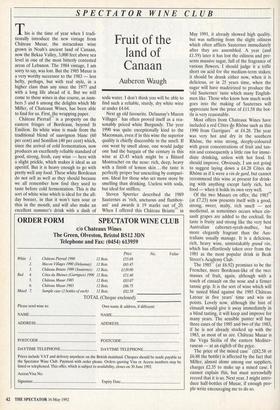SPECTATOR WINE CLUB
Fruit of the land of Canaan
Auberon Waugh
Château Pierrail is a property on the eastern fringes of Bordeaux, beyond St Emilion. Its white wine is made from the traditional blend of sauvignon blanc (60 per cent) and Semi!Ion (40 per cent) which, since the arrival of cold fermentation, now produces an excellently reliable standard of good, strong, fresh, easy wine — here with a slight prickle, which makes it ideal as an aperitif. But it is heavy enough to go with pretty well any food. These white Bordeaux do not sell as well as they should because we all remember how foul they used to taste before cold fermentation. This is the sort of white wine which is ideal for the all- day boozer, in that it won't turn sour or thin in the mouth, and will also make an excellent summer's drink with a dash of soda water. I don't think you will be able to find such a reliable, sturdy, dry white wine at under £4.64.
Next 12n old favourite. Delaunay's Macon Villages has often proved itself as a rea- sonably priced white Burgundy. The year 1990 was quite exceptionally kind to the Maconnais, even if in this wine the superior quality is chiefly discernible in the smell. If one went by smell alone, one would judge one had the bargain of the century in this wine at £5.45 which might be a Batard Montrachet on the nose: rich, deep, heavy with a finish of lemon skin ... the taste is perfectly proper but unexciting by compari- son. Ideal for those who set more store by smelling than drinking. Useless with soda, but ideal for sniffers.
Steven Spurrier described the 1989 Sauternes as 'rich, unctuous and flamboy- ant' and awards it 19 marks out of3)20. When I offered this Château Briatte in
May 1991, it already showed high quality, but was suffering from the slight oiliness which often afflicts Sauternes immediately after they are assembled. A year (and £1.59) later it has lost the oiliness and pre- sents massive sugar, full of the fragrance of various flowers. I should judge it a trifle short on acid for the medium-term stakes; it should be drunk either now, when it is delicious, or in 25 years time, when the sugar will have madeirized to produce the 'old Sauternes' taste which many English- men like. Those who know how much work goes into the making of Sauternes will appreciate how the price of £11.58 the bot- tle is very reasonable.
Most offers from Chateaux Wines have included a red Cotes u Rhone such as this 1990 from Garrigues at £4.28. The year was very hot and dry in the southern Rh6ne, the wine strong, deeply-coloured with great concentrations of fruit and tan- nin and consequently a little raw for imme- diate drinking, unless with hot food. It should improve. Obviously, I am not going to suggest laying down a £4.28 Cotes du RhOne as if it were a yin de gard, but cannot recommend this wine at present for drink- ing with anything except fairly rich, hot food — when it holds its own very well. 61 Of the two Musars on offer, the 1983( (at £7.23) now presents itself with a good, strong, sweet, malty, rich smell — not medicinal, as sometimes occurs when cin- sault grapes are added to the cocktail. Its taste is fruity and strong like the very best Australian cabernet-syrah-malbec, but more elegantly fragrant than the Aus- tralians usually manage. It is a delicious, rich, heavy wine, unmistakably grand yin, which has effortlessly taken over from the 1981 as the most popular drink in Beak Street's AcaMemy Club.
The 1985 (at £6.92) promises to be the Frencher, more Bordeaux-like of the two: masses of fruit, again, although with a touch of cinsault on the nose and a firmer tannic grip. It is the sort of wine which will be tasted blind against the 1985 Château Latour in five years' time and win on points. Lovely now, although the hint of cinsault would give it away immediately in a blind tasting, it will keep and improve for many years. The sensible punter will buy three cases of the 1985 and two of the 1983,
if he is not already stocked up with the 1983, as most of us are. Château Musar is the Vega Sicilia of the eastern Mediter- ranean — at an eighth of the price.
The price of the mixed case (£82.58 or £6.88 the bottle) is affected by the fact that Miller, almost alone among our suppliers, charges £2.35 to make up a mixed case. I cannot explain this, but must sorrowfully record that it is so. Next year, I might intro- duce half-bottles of Musar, if enough peo- ple write encouraging me to do so.


















































 Previous page
Previous page